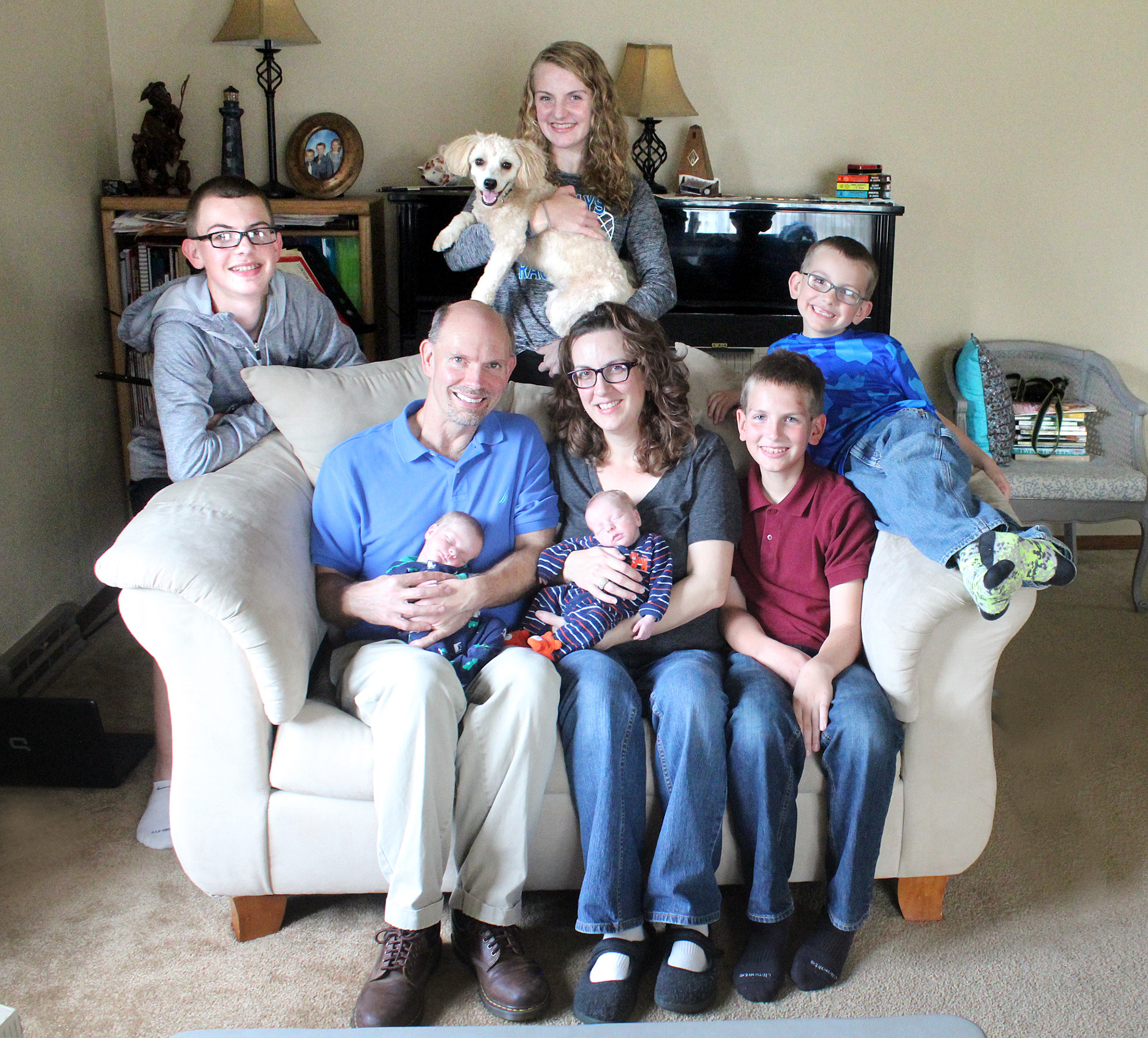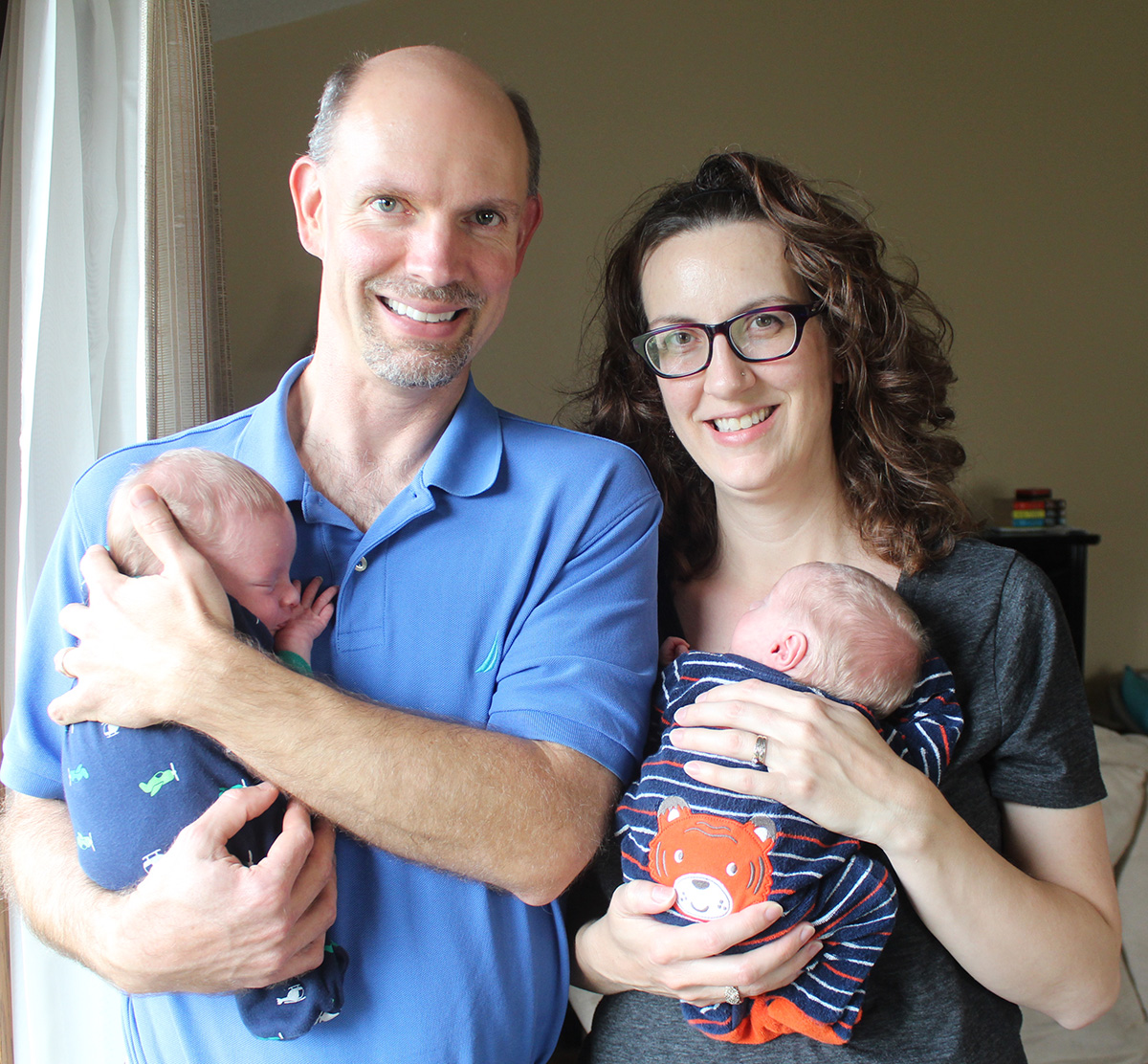 ,
, 
Twin brothers Knox and Sawyer came into the world the usual way — as “usual” as twin births can be.
They spent a few extra weeks in the hospital after their Sept. 23 birthday, but today they’re perfectly healthy baby boys.
It was the journey leading up to their arrival that was unusual — and some might say miraculous.
At the very least, they tested the outer limits of what modern medicine can do.
Their parents, Jason and Annalisa Cunningham, already have four healthy children, 15-year-old Carissa, 14-year-old Graham, 12-year-old Pierce and 6-year-old Colberg.
But they considered one more, perhaps another girl … “So we thought we’d see what would happen,” Annalisa said casually.
As blessings happen, they found themselves expecting again — this time twins.
They found out early in the pregnancy because Annalisa was experiencing some pain and bleeding.
“The ultrasound tech showed us one healthy baby and then said she was going to look a little more. All of a sudden there were two babies on the screen,” Jason said.
“I was shocked, and it was a good thing I was sitting down, as I probably would have fainted.”
They weren’t planning for two, but the Cunninghams took the news in stride. After all, they had already successfully navigated four healthy pregnancies.
“She took it in stride, I guess, but I was incredibly shocked,” Jason said. “This was at six weeks into the pregnancy. So things were exciting even before they became really exciting.”
So they prepared their little family for the arrival of twins, and they braced for extra medical attention that the pregnancy would require.
But there was no way to prepare for the news they received at their 20-week checkup.
‘Special’ condition
Their babies had developed twin-to-twin transfusion syndrome (TTTS), a disease of the placenta that affects identical twin pregnancies.
It’s a rare condition that affects identical twins who share a common placenta. ... One takes on excess fluid and the other ends up with no amniotic fluid.
It affects about 15 percent of identical twin pregnancies, and only 1 in 4,000 pregnancies.
“So they were special,” Annalisa said. “They decided to be really special and have TAPS, too,” she said.
In TAPS, there is an imbalance of red blood cells between the babies; one is anemic, and one has thick blood.
The combined conditions put both twins at risk of cardiac complications, organ failure and death.
Once the condition was discovered, doctors acted quickly. A complicated, delicate, high-risk surgery would be needed to save the twins, and there are only five hospitals in the United States that are equipped to do it.
Their doctor arranged for them to go to Colorado Institute for Maternal and Fetal Medicine. “We got a call at 10 a.m. on June 22 and by 2 p.m. we were on a plane,” Jason said. “They had made our flight arrangements for us.”
Annalisa said it put the rest of their family in a bind.
“We don’t have any family here, so we had to dump our other children on the neighbors,” she said.
Once in Denver, Annalisa and the unborn twins were subjected to a barrage of tests, ultrasounds and MRIs to determine if intrauterine laser surgery would save the twin pregnancy.
On June 24, surgeons gave it their best shot.
“There were 20 people on the surgery team and lots of blood on hand,” said Annalisa, who was conscious through the procedure. “I’ve never seen that many people in an operating room. It was crazy.”
As a registered nurse in high-risk OB/GYN (now a nurse practitioner), Annalisa was well aware of the risks. “I knew way too much,” she said.
The babies’ survival hinged on a pin prick of a laser instrument that would be just enough to equalize the fluid and blood flow without harming either of the babies … and without causing a tear in the amniotic membrane.
The laser surgery was successful. “After that, we basically waited,” Jason said. “To make sure the babies were OK … still alive basically.”
Delicate condition
After several more days in Denver, doctors cleared them to go home on June 29. But on the Fourth of July weekend, flights were hard to come by and four times the regular ticket price.
And Annalisa by this time was traveling in a wheelchair. “I gained a whole new appreciation for wheelchair living,” she said.
The flight home would turn out to be the least of their challenges.
With the twins’ precarious condition, Analisa was essentially on bed rest. No bending over, no lifting anything over 10 pounds and no walking past 200 steps per day — which essentially allowed her trips to the shower and the toilet.
The goal was to prevent labor for at least another eight weeks. But even if Annalisa did everything right, there was no preventing one of the twins from poking a finger or toe through the fragile opening, causing a tear — which would prompt labor.
“At 20 weeks there’s no guarantee,” Annalisa said. “Babies born at 28 weeks can survive, but getting from 20 weeks to 28 weeks was really nerve-wracking.”
While the Cunninghams were glad to be home, managing a family of six from a wheelchair presented a whole new set of challenges.
For one thing, Annalisa was allowed only 200 steps per day and she couldn’t lift more than 10 pounds.
And because she had gestational diabetes (as a result of limited mobility), her carb and sugar intake was severely restricted at the same time she was trying to take in nutrients so the babies would grow.
“I could have a one-bread sandwich for lunch, or a half English muffin for breakfast,” she said. “It was tricky because I was on a low-sugar, high calorie diet.”
She survived primarily on meat, cheese, eggs and other protein.
“After the twins were born, Jason brought me a double chocolate mocha.”
She said their family also missed out on many joys of summer, such as gardening, family trips, neighborhood walks, and more.
But through it all, they said they were grateful for the support of their church, First Presbyterian in Luverne, where Jason is the pastor.
“They were really understanding,” he said.
Homecoming
As it turns out, the sacrifices paid off.
The crucial 28-week mark came and went, and then they set their sights on 30 weeks, which passed without incident. “The average delivery for twins is at 31 weeks; we made it to 34,” Annalisa said.
She said she’s proud to have reached that stage and proud to have done it at home. Had the twins’ condition changed, she would have spent bed rest in the hospital.
The babies were delivered by C-section on Sept. 23 in Sioux Falls. Knox weighed 4 pounds, 14 ounces, and Sawyer weighed 5 pounds, 2 ounces, and they’re gaining.
The identical boys still wear their ankle bracelets so people can tell them apart, but their parents say it’s getting easier. “Sawyer’s a little bigger,” Jason said. “And he’s getting an attitude. If he’s hungry, he’ll let you know right away.”
As they’re settling into their new routine, the bills continue to pile up.
Paying the bills
In addition to their $14,000 deductible, they’re facing travel costs and other costs associated with the pregnancy and delivery.
“On top of our out-of-pocket amounts, some of the Denver medical procedures were not covered by insurance,” Jason said.
To help them out, the Deacons of First Presbyterian Church organized a fundraiser from 9 a.m. to 1 p.m. Sunday, Nov. 13, in the Blue Mound Banquet Center, Luverne.
The event includes brunch — eggs, sausage, pancakes, etc. — and a silent auction, which is supported and promoted by the Rock County Ministerial Association.
“With the help of the friends and families of the Cunninghams and everyone in our community, we believe we will reach our goals,” said Cory Grimm on behalf of the Ministerial Association.
“The Cunninghams have dedicated themselves to serving the people of Rock County during this season of their lives, and this is our chance to show them our appreciation and to work together across denominational lines for the glory of God.”
In addition to the fundraiser event, a GoFundMe page was started at www.gofundme.com/cunninghamtwins.
“It’s a really nice town,” Jason said about the support they’ve received.
In his church newsletter, he expressed their gratitude.
“We are very grateful for all of the prayers and encouragement from the congregation,” Jason wrote in the church newsletter. “We are also very thankful for the meals people have provided and cards we have received.”
Along the way, they noticed help from higher places too, such as short-notice doctor appointments and airline flights being available when they were critically needed.
“… the twins most likely would have been lost because they never would have survived … with how fast the TTTS and TAPS were moving,” Jason said.


